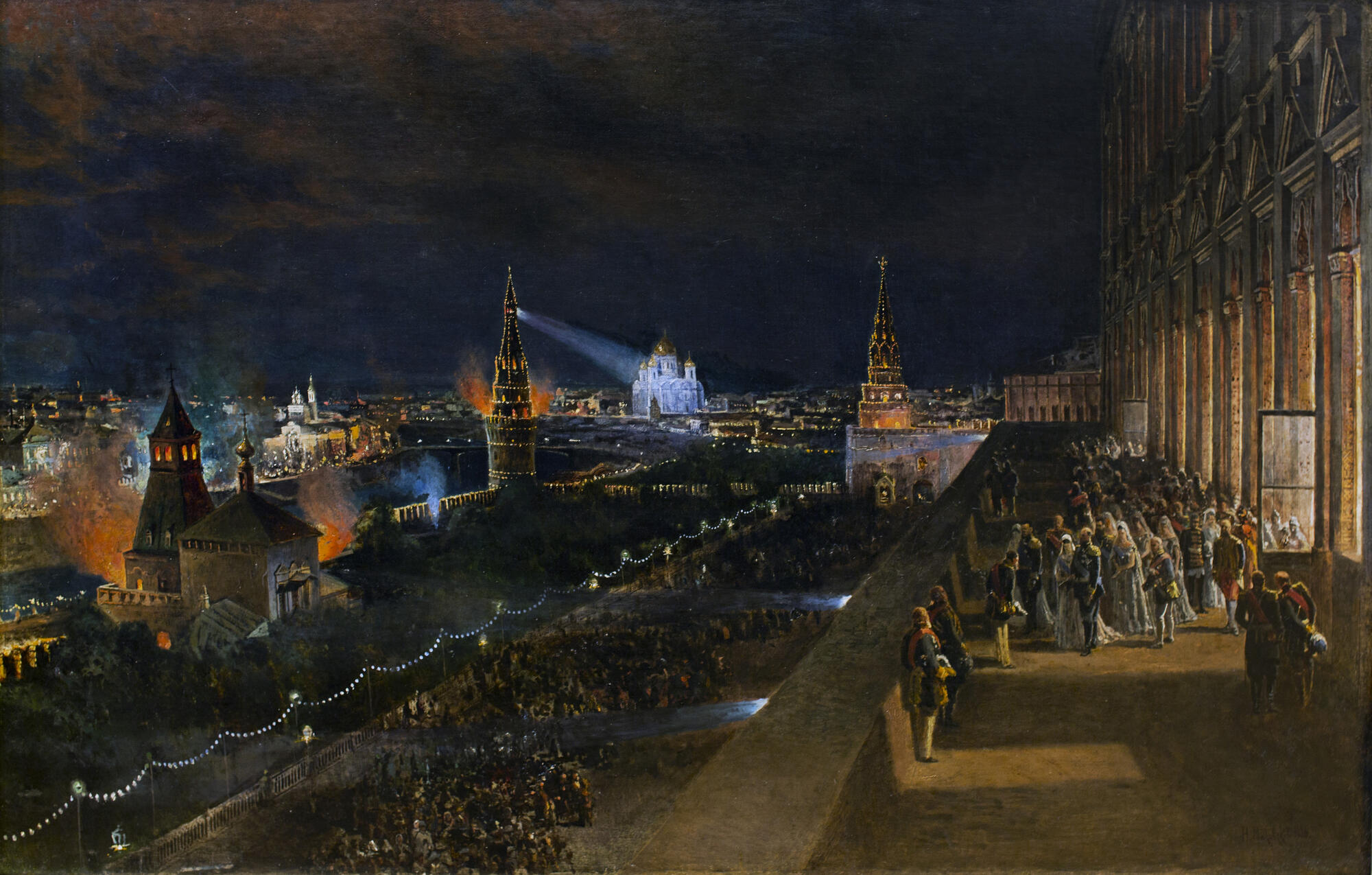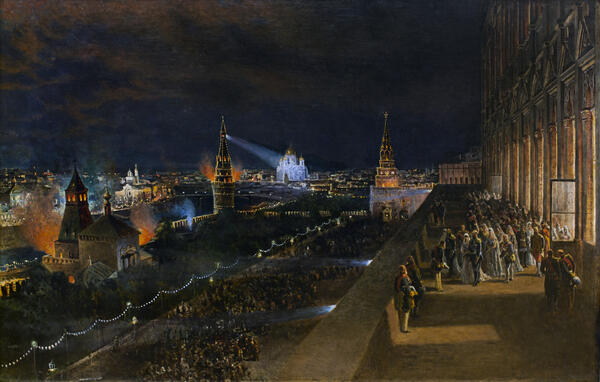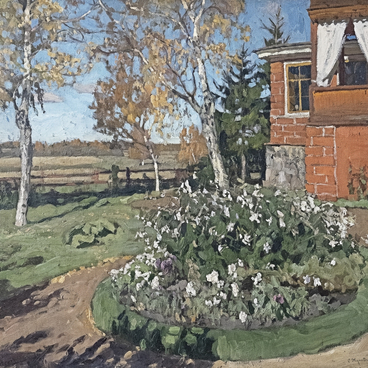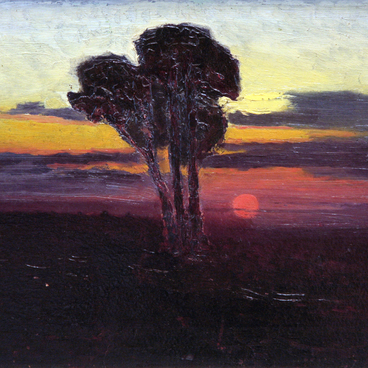Nikolaу Makovsky, who belonged to a group of Russian Realist painters known as the Wanderers, painted ‘Illumination of Moscow’ in the 1880s in honor of the coronation of Emperor Alexander III. The coronation took place at the same time as the consecration of the Cathedral of Christ the Savior, one of the main churches in Moscow.
According to the tradition, the coronations of Russian emperors were held in the Assumption Cathedral of the Moscow Kremlin. A few days before the celebration, mass festivities began, balls and celebrations were organized in the city, the streets and buildings of the capital were lavishly decorated.
In the painting, Nikolaу Makovsky depicted a large-scale illumination of the city, which he witnessed with his own eyes. To arrange the illumination, a separate small power plant was built in Moscow, and a large-scale project was prepared by an artist Petr Boytsov and an engineer-colonel Mikhail Fabritius. The Red Square, theaters and cathedrals, the Sophia Embankment and the Alexander Garden were decorated with colored lanterns. But the main surprise for the townspeople was the decoration of the walls and towers of the Moscow Kremlin with the brand-new technical achievement — electric bulbs. They all lit up at once, as soon as Alexander III with his wife and courtiers appeared on the balcony of the Grand Kremlin Palace. The show produced a strong impression on the residents of Moscow.
Among the lights and architectural forms, the illuminated Cathedral of Christ the Savior stands out as a bright patch on the canvas. Makovsky combined two significant historical events — the coronation celebrations and the opening of the church — on one painting. This made it possible to place ‘Illumination of Moscow’ not only in the cityscape, but also in the history painting genre.
Nikolay Makovsky was born into a creative family, in which four out of five children followed in the footsteps of their father — an artist and one of the founders of the Moscow School of Painting, Sculpture and Architecture. Nikolay’s brothers — Konstantin and Vladimir Makovsky — were famous painters.
Makovsky graduated from the Imperial Academy of Arts and received the credentials of an architect. However, before long he made his choice in favor of painting. Together with other artists, he became one of the founders of the Society of Travelling Art Exhibitions. The Wanderers sought to get closer to the common people, to find and comprehend their cultural roots. Apart from practicing arts, the members of the society also conducted educational activities. Thus, they opposed themselves to the academicians, who believed that only a narrow circle of educated people — intelligentsia — would be able to appreciate and understand art. Nikolay Makovsky would now and then participate in the exhibitions organized by the Wanderers society.
Most of the artist’s works are landscapes, urban and architectural scenes, which he painted while traveling in Egypt and Russia.
According to the tradition, the coronations of Russian emperors were held in the Assumption Cathedral of the Moscow Kremlin. A few days before the celebration, mass festivities began, balls and celebrations were organized in the city, the streets and buildings of the capital were lavishly decorated.
In the painting, Nikolaу Makovsky depicted a large-scale illumination of the city, which he witnessed with his own eyes. To arrange the illumination, a separate small power plant was built in Moscow, and a large-scale project was prepared by an artist Petr Boytsov and an engineer-colonel Mikhail Fabritius. The Red Square, theaters and cathedrals, the Sophia Embankment and the Alexander Garden were decorated with colored lanterns. But the main surprise for the townspeople was the decoration of the walls and towers of the Moscow Kremlin with the brand-new technical achievement — electric bulbs. They all lit up at once, as soon as Alexander III with his wife and courtiers appeared on the balcony of the Grand Kremlin Palace. The show produced a strong impression on the residents of Moscow.
Among the lights and architectural forms, the illuminated Cathedral of Christ the Savior stands out as a bright patch on the canvas. Makovsky combined two significant historical events — the coronation celebrations and the opening of the church — on one painting. This made it possible to place ‘Illumination of Moscow’ not only in the cityscape, but also in the history painting genre.
Nikolay Makovsky was born into a creative family, in which four out of five children followed in the footsteps of their father — an artist and one of the founders of the Moscow School of Painting, Sculpture and Architecture. Nikolay’s brothers — Konstantin and Vladimir Makovsky — were famous painters.
Makovsky graduated from the Imperial Academy of Arts and received the credentials of an architect. However, before long he made his choice in favor of painting. Together with other artists, he became one of the founders of the Society of Travelling Art Exhibitions. The Wanderers sought to get closer to the common people, to find and comprehend their cultural roots. Apart from practicing arts, the members of the society also conducted educational activities. Thus, they opposed themselves to the academicians, who believed that only a narrow circle of educated people — intelligentsia — would be able to appreciate and understand art. Nikolay Makovsky would now and then participate in the exhibitions organized by the Wanderers society.
Most of the artist’s works are landscapes, urban and architectural scenes, which he painted while traveling in Egypt and Russia.





